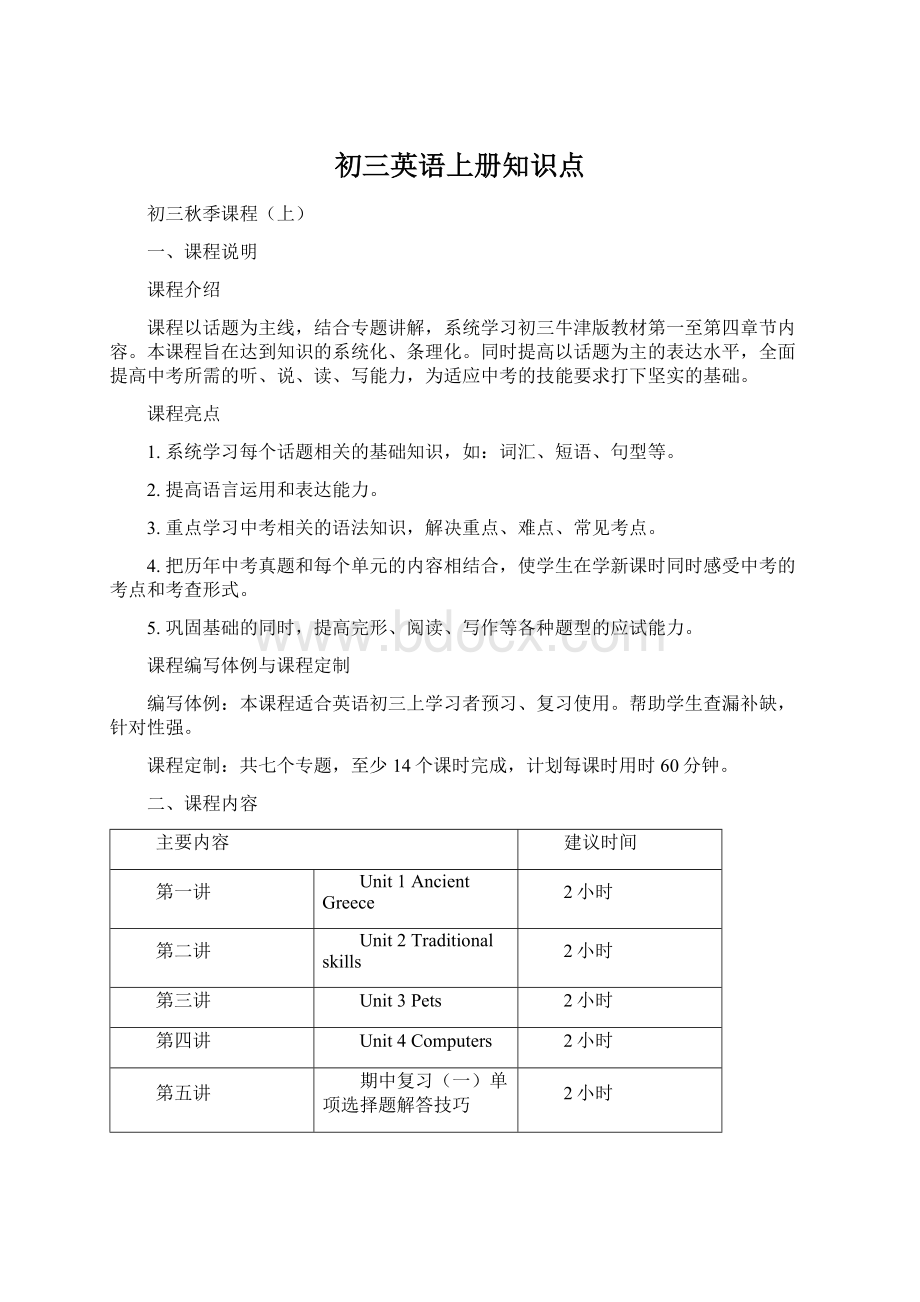初三英语上册知识点Word格式.docx
《初三英语上册知识点Word格式.docx》由会员分享,可在线阅读,更多相关《初三英语上册知识点Word格式.docx(170页珍藏版)》请在冰豆网上搜索。

第一讲AncientGreece
一.Words
stair
including
plain
Troy
lookdownat
seize
beyond
drag
sail,
gotosleep
interrupt
succeedin
darkness
obey
heel
citizen
stupid
trick
exceptfor
giant
secret
disappear
1.interruptsb.
2.disappearVS.vanishVS.appear
3.capture&
catch
4.helpsb.;
helpsb.withsth.;
helpsb.(to)dosth.helpful;
helpless
5.obeysth.disobeysth.breaksth.
6.orderN.&
.V
A、名词order作“顺序”、“次序”、“整齐”、“秩序”解:
1.Themachineisingoodworkingorder.机器运转良好。
2.Thefourseasonsfollowinorder.四个季节依次轮换。
3.Ourlaboratoryiskeptingoodorder.我们的实验室保持整齐。
(ingoodorder为主语补语。
)
4.Incasethedeviceisoutoforder,youhavetorepairitatonce.如果该装置发生故障,你就得马上修理。
B、名词order作“订货”、“订货单”、“数量级或范围”、“命令”解:
1.Thefactoryhasreceivedanorderfor2,000machinetools.工厂受到了一张要买2,000台机床的订货单。
2.Hegaveordersfortheworktobestarted.
(=…ordersthattheworkshouldbestarted.)他下令开始工作。
C、用“inorder+带to的不定式”表示目的状语:
1.Theytookofftheirshoesupon(on)entering,inordernottosoilthemats.
他们进来时都脱鞋,免得弄脏地毯。
注1:
有时可省略inorder,而直接用不定式表示目的状语:
Wehaveproducedalotoftractors(inorder)tomeettheneedsofouragriculture.
我们生产了许多拖拉机以满足我们农业的需要。
注2:
注意inorder后面出现不定式的逻辑主义for…的情况:
Inorderfortwoforcestoneutralizeeachother,theymustactonthesameobject.
为了使两个力互相抵消,它们必须作用于同一物体上。
D、用“inorderthat”引导目的从句:
4.Theoldworker,inorderthattheremightbenotimelost,oiledthemachineshimself.
为节省时间,老工人亲自给机器上油。
注:
在inorderthat引出的目的状语从句内,常用情态动词may,might,can,could,shall等。
当目的的状语从句在句末时,还常可用sothat或totheendthat代替inorderthat。
E、动词order作“定制”、“订购”、“命令”解:
1.Theyhaveordered1,000oilpumpsfromourfactory.他们已向我厂订购1,000台油泵。
2.Thedoctororderedhimtostaythere.医生嘱咐他留在那里。
(不定式短语tostaythere作宾语补语)
order与book的区别
1.book预订,往往用于“订座、订票”在电影院、剧院、车站等处订票、座。
IhavebookedtwoticketstoNewYork.我订了两张去纽约的票。
2.order指定购,向商店定购肥料,定制衣服、饭店定饭。
orderasuit定制一套衣服
典型例句:
Heorderedhisstafftoorder100booksandputtheminorderofsize.
7.celebratesth.(with)sth.celebration
8.stupid
1)Itis+adj.+ofsb.+todosth中的adj.跟sb.有关,
这个adj.是用来形容sb.的,表示某人这么做真是太adj.了.你会发现在这个句型中你把sb.和adj.提出来可以造个句sb.is(are)adj.如
It‘sverykindofyoutohelpme.把里面的sb.和adj.提出来可以发现youarekind是说得通的.
2)而Itis+adj.+forsb.+todosth表示做某事对某人来说很adj.这里的adj.是dosth.的属性
里面的sb.跟adj.没有直接联系
如It‘sdifficultforyoutodealwiththeproblem.你就不能说youaredifficult.
结论:
若形容词是描述不定式行为者的性格、品质的,如kind,good,nice,right,wrong,clever,careless,polite,foolish等,用ofsb.。
It’sverykindofyoutohelpme.你能帮我,真好。
It’scleverofyoutoworkoutthemathsproblem.你真聪明,解出了这道数学题。
若形容词仅仅是描述事物,不是对不定式行为者的品格进行评价,用forsb.,这类形容词有difficult,easy,hard,important,dangerous,(im)possible等。
It’sverydangerousforchildrentocrossthebusystreet.对孩子们来说,穿过繁忙的街道很危险。
It’sdifficultforustofinishthework.对我们来说,完成这项工作很困难。
9.include
1)include动词。
"
包括、包含;
算在内,列在里面"
Pleaseincludemeinyourgroup.请把我算在你们组内.
2)including介词."
包括在内"
Therearefourpeopleinmyfamily,includingme.包括我在内,我家四口人.
3)included形容词.用于名词和代词后"
Therearefourpeopleinmyfamily,meincluded.
4)contain动词."
包容,装着"
Theboxcontainstenapples.这个盒子里装着十个苹果.
include和contain一个明显的区别是:
include的主语和宾语属于同一范畴;
而contain的主语相当于一个"
容器"
contain的宾语就是这个"
里所含有的东西.
10.seizesb./sth.Heseizedmebythearm.grabsb./sth.take/getholdofloose
11.succeed
1)succeed的用法:
succeed表示“成功”,是不及物动词,因此不能用于被动语态。
Hisplansucceeded.他的计划成功了。
2)表示做某事做成功了,succeed后通常不接不定式,而接indoingsth。
Atlasthesucceededinsolvingtheproblem.他终于把那个问题解决了。
2)success的用法
Failureisthemotherofsuccess.失败是成功之母。
success表示抽象意义的“成功”,是不可数的;
表示具体意义的“成功的人或事”,则是可数的。
比较:
Gigsuccessdoesnotusuallyoccurearly.(大器晚成).
Hisnewbookwasagreatsuccess.(他新出版的书获得了巨大成功)。
havesuccessindoingsth=做某事有结果或效果。
Didyouhaveanysuccessinpersuadinghertochangehermind?
你说服她改变主意了吗?
3)successful的用法
successful=成功的;
successive=连续的,接连的,一连串的。
如:
Wehavewonfivesuccessivegames.(我们已连胜五场比赛)。
Theperformancewassuccessful.演出很成功。
表示成功地做某事,besuccessful后不能接不定式,而是接indoingsth,又如:
Theyweresuccessfulinlaunchingacommunicationsatellite.(他们成功地发射了一颗通讯卫星)。
Wereyousuccessfulinfindinganewhouse?
你想找所新房子你找到了吗?
12.except
(1)besides与except
前者表示"除...以外,还有...";
后者表示"从整体中除去..."
这个大家都知道,就不举例子了.
2)except与exceptfor
a.除去的和非除去的是同类事物,用except
AlltheessaysarewellwrittenexceptNelson'
s.
Nelson的文章(除去的)和Alltheessays(非除去的)是同类事物,所以用except.
b.除去的和非除去的不是同类事物,用exceptfor,并且从语气上通常表示遗憾.
Hisessayiswellwrittenexceptforafewspellingmistakes.
afewspellingmistakes(除去的)和Hisessay(非除去的)是不同类的事物.
13.so…that
A.so...that与too...to的转换
当that引导的从句为否定式时,从句主语与主语的主语相同时,so...that可转换为too...to结构;
若从句主语与主句的主语不相同时,so...that可转换为too...forsb.to结构。
例如:
Heissoyoungthathecan'
tgotoschool.→Heistooyoungtogotoschool.
Theboxissoheavythathecan'
tliftit.→Theboxistooheavyforhimtolift.
B.so...that与enoughto的转换
1.当that引导的从句为肯定式时,若从句主语与主句主语相同时,so...that可转换为enoughto结构;
若从句主语与主句主语不相同时,so...that可转换为enoughforsb.to结构。
Tomissooldthathecangotoschool.→Tomisoldenoughtogotoschool.
Theboxissolightthatthechildcanliftit.→Theboxislightenoughforthechildtolift.
2.当that引导的从句为否定式时,若从句主语与主句主语相同时,so...that可转换为enoughto的否定结构;
若从句主语与主句主语不相同时,so...that可转换为enoughforsb.to的否定结构。
注意:
转换后的形容词(副词)要用其相应的反义词。
Themanissooldthathecan'
tgotowork.→Themanisn'
tyoungenoughtogotowork.
ThedeskissoheavythatIcan'
tmoveit.→Thedeskisn'
tlightenoughformetomove.
C.enoughto的句式为否定式时,enoughto可以转换为too...to结构。
但转换后的too...to结构中的形容词(副词)要用其相应的反义词。
Heisnotoldenoughtodothejob.→Heistooyoungtodothejob.
Tomdidn'
twalkslowlyenoughforustokeepupwithhim.→Tomwalkedtoofastforustokeepupwithhim.
14.with
1.表示方式、手段或工具等时(=以,用),注意不要受汉语意思的影响而用错搭配,如“用英语”习惯上用inEnglish,而不是withEnglish。
2.与某些抽象名词连用时,其作用相当于一个副词:
withcare=carefully认真地/withkindness=kindly亲切地/withjoy=joyfully高兴地/withanger=angrily生气地
3.表示条件时,根据情况可与虚拟语气连用:
WithmoremoneyIwouldbeabletobuyit.要是钱多一点,我就买得起了。
Withbetterequipment,wecouldhavefinishedthejobevensooner.要是设备好些,我们完成这项工作还要快些。
1.比较with和as:
两者均可表示“随着”,但前者是介词,后者是连词:
Hewillimproveashegrowsolder.随着年龄的增长,他会进步的。
People’sideaschangewiththechangeofthetimes.时代变了,人们的观念也会变化。
5.介词with和to均可表示“对”,但各自的搭配不同,注意不要受汉语意思的影响而用错,如在kind,polite,rude,good,married等形容词后通常不接介词with而接to。
6.复合结构“with+宾语+宾语补足语”是一个很有用的结构,它在句中主要用作状语,表示伴随、原因、时间、条件、方式等;
其中的宾语补足语可以是名词、形容词、副词、现在分词、过去分词、不定式、介词短语等:
Hewaslyingonthebedwithallhisclotheson.他和衣躺在床上。
Hefellasleepwiththelampburning.他没熄灯就睡着了。
Hesattherewithhiseyesclosed.他闭目坐在那儿。
Ican’tgooutwithalltheseclothestowash.要洗这些衣服,我无法出去了。
这类结构常用于名词后作定语:
Theboywithnothingonisherson.没穿衣服的这个男孩子是她儿子。
15.as
(一)、as作连词的用法:
1.作“在-------期间,当----的时候”引导时间状语从句.注意与when、
while的用法区别。
①下列情形时,只用as,
而不用when或while。
1)用于表示同一个人的两种动作交替进行,指一边----一边.
如:
The
girl
sings
as
she
goes
to
school.
2)表示两个同步发生的动作或行为,意思是随着-----的发展.如:
As
time
went
on
/
by,
became
more
and
beautiful
.
children
get
older,
they
become
interested
in
everything.
3)表示两个短暂行为或事情几乎同时发生.如:
I
watched
her
read
the
book.
thought
of
it
just
you
opened
your
mouth.
4)接在名词后面表示某一个年龄段时.如:
a
young
man,
he
was
active
sports.
②when作"
当……的时候"
解,可以指较短的(一点)时间,也可指一段时间。
When
at
college,
could
speak
several
foreign
languages.
clock
struck
twelve,
had
slept
for
2hours.
③
while常表示一段较长的时间或一个过程,强调主句谓语动词与从句谓语动词同时发生。
Work
while
work.
Play
play.
2.
=Since
作"
既然"
、"
由于"
解,引导原因状语从句,常用来表示已为人们所知或显而易见的原因或理由。
he’s
been
ill
ages,
will
help
him.
Since
you'
re
not
feeling
well,
may
stay
home.
3.
=in
way
that作"
像"
按照……的方式"
解,引导方式状语从句。
Remember,
must
do
everything
do.
4.
用于as---
as或not
so/
----
as中,前一个as是副词,后一个as是连词,引导比较状语从句。
They
helped
old
much
possible.
don'
t
English
well
does.
5.
表示虽然,尽管
等,引导让步状语从句,常用倒装语序,模式为:
adj.
/adv.
n.+as
+主语+谓语+主句。
Young
is,
knows
much.
Tired
were,
walked
on.
6.
表示也------一样。
She
is
doctor,
husband.
(二)、
as作关系代词,引导定语从句,表示正如,这一点.如:
He
very
careful,
we
all
know.As
well-known,
Taiwan
belongs
China.
另外,当先行词被the
same,
such等词修饰时,常用as来引导定语从句。
Such
clever
can
learn
anything
quickly.
reading
same
book
bought
yesterday.
(三)、as作介词的用法.
1.表示好像。
He
dressed
policeman.2.
表示作为当作。
found
job
guide.
当某人是某身份时。
child
sent
abroad.
as引导的介词短语大多用作状语,as译为"
作为"
;
少数情况可引起宾语补足语。
Party
member,
I'
ll
take
lead
(状语)
has
me
one
best
friends.(引起宾语补足语)
(四)、作副词的用法
1.
表示与------等同。
This
dress
twice
expensive
that
one.
像,如等。
before,
remained
unmoved.
16.sureVScertain
两者都可用作表语,表示“一定”或“确信”,有时可互换。
互换的场合应注意以下几点用法:
1.表示说话者的态度或看法
即表示说话者自己的态度或看法,其意为“一定会”“肯定会”。
此时主要用法有:
(1)单独用作表语。
Onethingwassure[certain]:
they’dbelate.有一件事是确定无疑的,他们会迟到。
(2)后接不定式。
He’scer